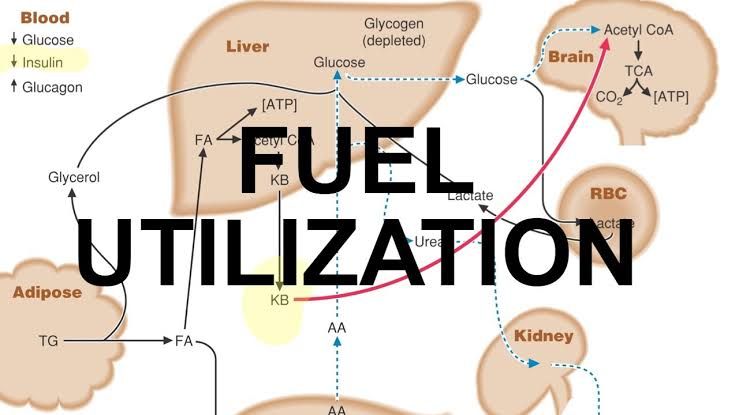
Metabolic Picture in the Well-Fed State and During Starvation
(a) Well-Fed State (Absorptive State)
The well-fed state, also known as the absorptive or postprandial state, occurs for about 3–5 hours after eating. During this time, blood glucose levels are high, stimulating insulin secretion from pancreatic beta cells. Insulin is the dominant hormone in this state and promotes anabolic processes such as glycogen synthesis, lipid storage, and protein synthesis while inhibiting catabolic pathways like gluconeogenesis and lipolysis.
- Liver:
- The liver plays a central role in nutrient metabolism during the well-fed state.
- Glycogen Metabolism: Insulin stimulates glycogen synthase activity, promoting glycogen synthesis from glucose-6-phosphate. Glycogen phosphorylase is inhibited to prevent glycogen breakdown.
- Glycolysis: Insulin upregulates glycolytic enzymes (e.g., phosphofructokinase-1) to oxidize glucose into pyruvate. Pyruvate is converted to acetyl-CoA for energy production or fatty acid synthesis.
- Hexose Monophosphate Pathway (HMP): Glucose-6-phosphate enters the pentose phosphate pathway to produce NADPH, which is essential for fatty acid and cholesterol biosynthesis.
- Lipid Metabolism: Excess acetyl-CoA from glycolysis is used for de novo fatty acid synthesis. These fatty acids are esterified into triglycerides and exported as very-low-density lipoproteins (VLDLs).
- Amino Acid Metabolism: Amino acids absorbed from dietary proteins are used for protein synthesis or deaminated to provide substrates for energy metabolism.
- Brain:
- The brain relies almost exclusively on glucose as its energy source during the well-fed state.
- Glucose uptake occurs via insulin-independent GLUT1 and GLUT3 transporters, ensuring a constant supply of glucose regardless of hormonal fluctuations.
- Muscle:
- Skeletal muscle takes up glucose through insulin-dependent GLUT4 transporters.
- Glycogen Metabolism: Insulin stimulates glycogen synthase to store excess glucose as glycogen.
- Protein Synthesis: Insulin promotes amino acid uptake and protein synthesis in muscle tissue.
- Adipose Tissue:
- Adipocytes take up glucose via insulin-dependent GLUT4 transporters.
- Glucose is metabolized through glycolysis to generate glycerol-3-phosphate, which combines with free fatty acids (from chylomicrons or VLDLs) to form triglycerides for storage.
- Lipoprotein lipase activity is increased by insulin, facilitating the uptake of fatty acids from circulating lipoproteins.
(b) Starvation
Starvation represents prolonged fasting beyond 24–48 hours when glycogen stores are depleted, and alternative fuels like ketone bodies become critical for survival. The body prioritizes maintaining blood glucose levels for essential tissues like the brain while conserving protein stores.
- Liver:
- The liver shifts from carbohydrate metabolism to fat-based energy production during starvation.
- Gluconeogenesis: The liver synthesizes glucose primarily from non-carbohydrate precursors such as lactate (via Cori cycle), glycerol (from triglyceride breakdown), and amino acids (from muscle proteolysis). This process is driven by glucagon and cortisol.
- Ketogenesis: Free fatty acids released from adipose tissue undergo β-oxidation in hepatocytes to produce acetyl-CoA. Excess acetyl-CoA is converted into ketone bodies (β-hydroxybutyrate and acetoacetate), which serve as an alternative fuel source for peripheral tissues like the brain and muscles.
- Glycogen stores are typically depleted within 24 hours of fasting.
- Brain:
- Initially dependent on glucose supplied by hepatic gluconeogenesis during early starvation phases.
- After several days of starvation, ketone bodies become the primary fuel source for neurons, reducing reliance on glucose and sparing muscle protein breakdown.
- Muscle:
- Muscle tissue reduces its reliance on glucose during starvation by switching to fatty acid oxidation as its primary energy source.
- Ketone bodies can also be oxidized by skeletal muscle during prolonged fasting.
- Cortisol-mediated proteolysis releases amino acids like alanine and glutamine into circulation for gluconeogenesis in the liver.
- Adipose Tissue:
- Lipolysis becomes the dominant metabolic process in adipose tissue during starvation due to elevated glucagon, epinephrine, and cortisol levels.
- Triglycerides stored in adipocytes are hydrolyzed into free fatty acids and glycerol. Free fatty acids are transported to other tissues for β-oxidation or ketogenesis in the liver.
Regulation of Key Metabolic Pathways by Insulin/Counter-Regulatory Hormones Ratio
The balance between insulin (an anabolic hormone) and counter-regulatory hormones such as glucagon, cortisol, epinephrine, and norepinephrine determines whether metabolic pathways favor storage or mobilization of nutrients.
1. Glycogen Metabolism
- High insulin-to-glucagon ratio (well-fed state):
- Activates glycogen synthase → Promotes glycogen synthesis in liver/muscle.
- Inhibits glycogen phosphorylase → Prevents glycogen breakdown.
- Low insulin-to-glucagon ratio (fasting/starvation):
- Activates glycogen phosphorylase → Stimulates glycogenolysis in liver/muscle.
- Inhibits glycogen synthase → Halts further storage of glycogen.
2. Glycolysis
- High insulin-to-glucagon ratio:
- Upregulates key glycolytic enzymes like phosphofructokinase-1 (PFK-1) → Enhances conversion of glucose into pyruvate for ATP production or lipid biosynthesis.
- Low insulin-to-glucagon ratio:
- Inhibits glycolytic enzymes → Conserves glucose for essential tissues like brain/RBCs.
3. Hexose Monophosphate Pathway
- High insulin-to-glucagon ratio:
- Stimulates HMP shunt → Produces NADPH required for lipid biosynthesis in liver/adipose tissue.
- Low insulin-to-glucagon ratio:
- Reduces HMP activity due to limited substrate availability under fasting conditions.
4. Gluconeogenesis
- High insulin-to-glucagon ratio:
- Suppresses gluconeogenic enzymes → Prevents unnecessary production of glucose when dietary carbohydrates are abundant.
- Low insulin-to-glucagon ratio:
- Activates gluconeogenic enzymes like pyruvate carboxylase → Ensures continuous supply of glucose during fasting/starvation using non-carbohydrate precursors.
5. Lipid Metabolism
- High insulin-to-glucagon ratio:
- Promotes de novo lipogenesis via activation of acetyl-CoA carboxylase → Converts excess carbohydrates into triglycerides stored in adipose tissue/liver.
- Inhibits hormone-sensitive lipase → Prevents triglyceride breakdown in adipocytes.
- Low insulin-to-glucagon ratio:
- Activates hormone-sensitive lipase → Mobilizes stored triglycerides into free fatty acids/glycerol during fasting/starvation.
6. Amino Acid Metabolism
- High insulin-to-glucagon ratio:
- Enhances amino acid uptake/protein synthesis in skeletal muscle/liver under fed conditions.
- Low insulin-to-glucagon ratio:
- Stimulates proteolysis mediated by cortisol → Releases amino acids like alanine/glutamine for hepatic gluconeogenesis during prolonged fasting/starvation.







